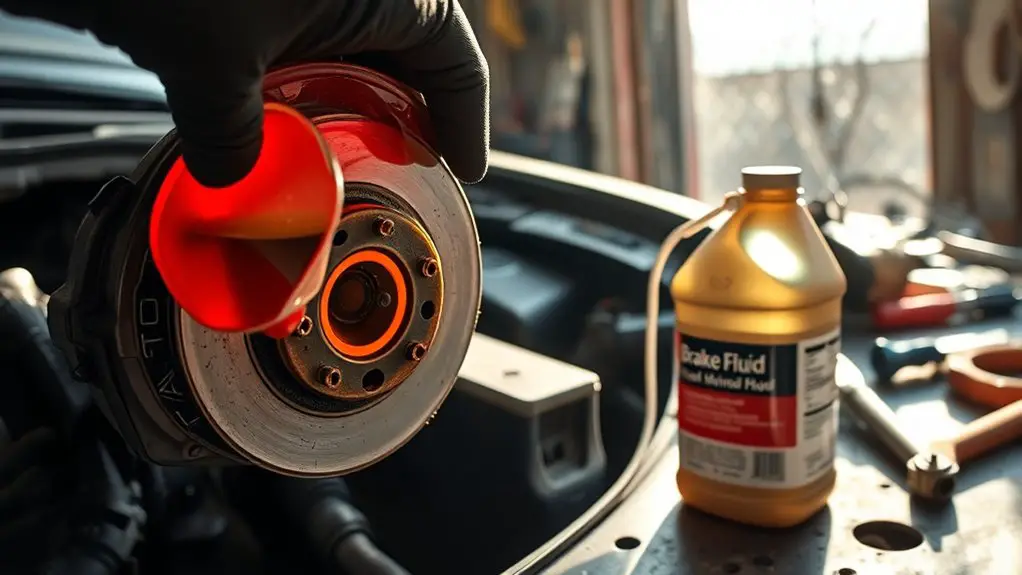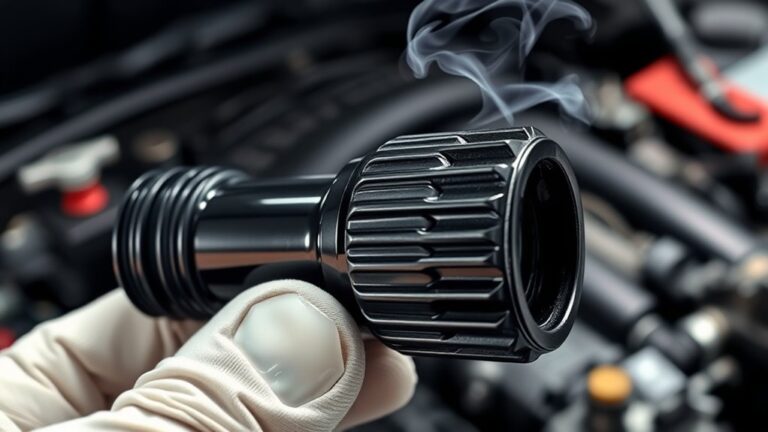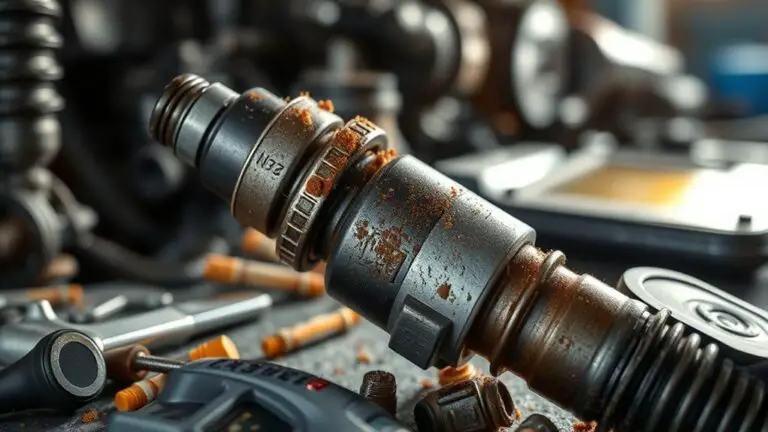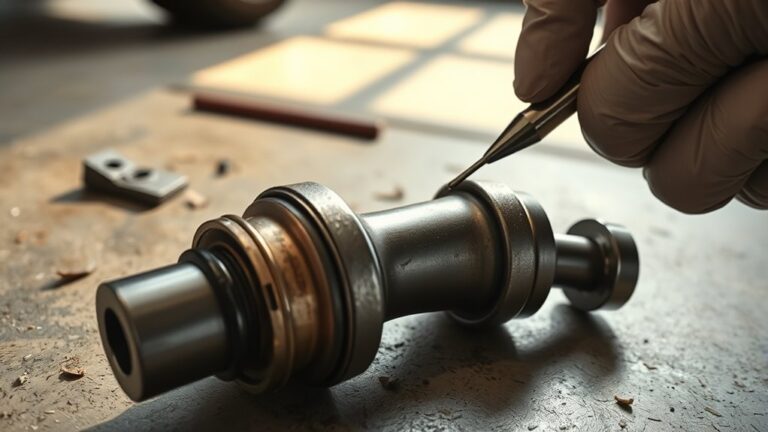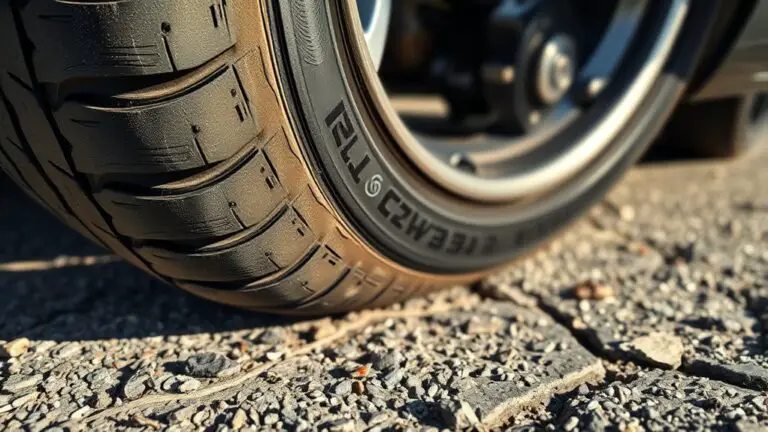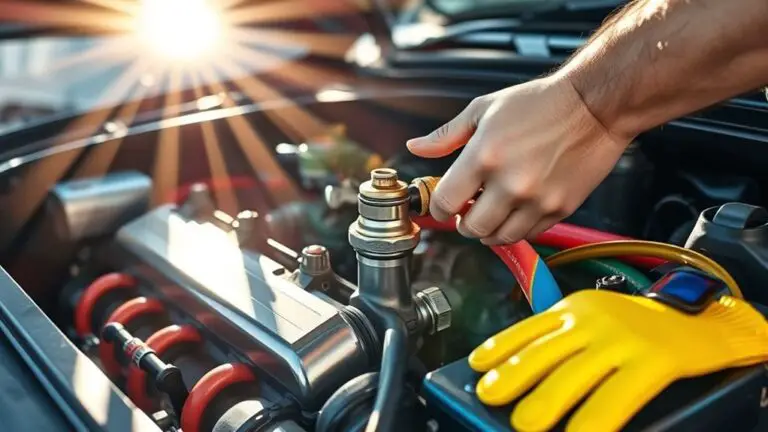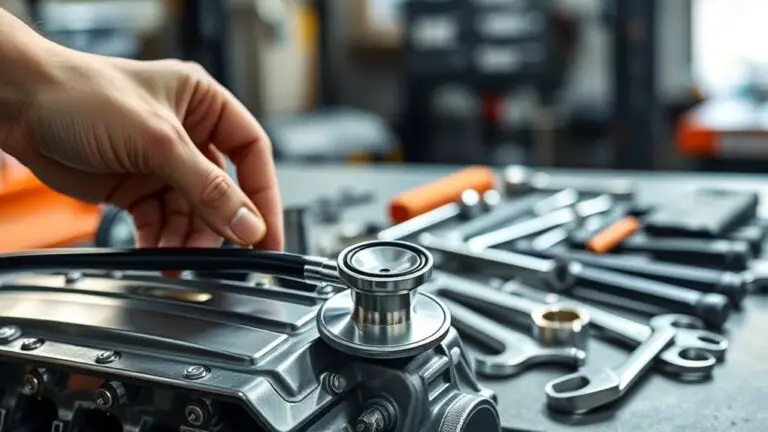Common Mistakes When Replacing Brake Fluid
When replacing brake fluid, don’t ignore the fluid type specified in your vehicle manual. Failing to check the fluid’s condition, neglecting to clean the reservoir, and overlooking proper brake bleeding can all lead to issues. Make sure to check for leaks and avoid overfilling the reservoir. Always test the brakes after the replacement, and don’t delay maintenance. Ignoring manufacturer recommendations can risk corrosion and inefficiency. There’s more to take into account for ideal brake performance.
Ignoring the Brake Fluid Type
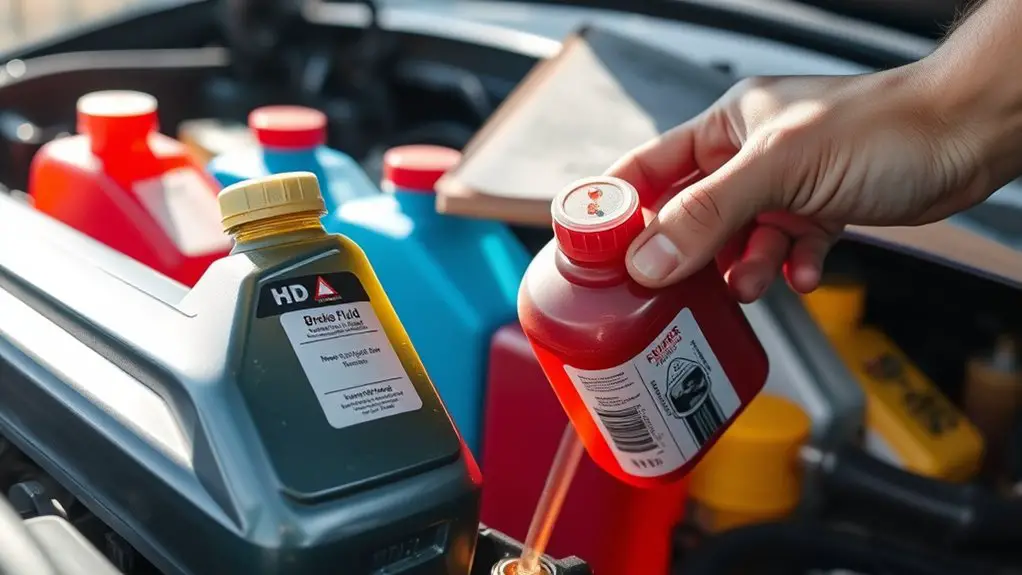
One of the most critical mistakes you can make when replacing brake fluid is ignoring the specific type required for your vehicle. Each vehicle manufacturer specifies a brake fluid type to guarantee peak performance and safety. Using the wrong fluid compromises brake fluid compatibility and can lead to brake failure.
To avoid this issue, start with fluid type identification. Check your owner’s manual or the brake fluid reservoir cap for the correct specifications, often denoted as DOT 3, DOT 4, or DOT 5. Each type has different chemical properties designed for specific systems.
If you’re unsure, consult with a professional or refer to reliable automotive resources. Remember, choosing the right brake fluid isn’t just about maintenance; it’s about guaranteeing your freedom on the road. When your brakes function correctly, you’re empowered to drive confidently, knowing you’ve made the right choice for your safety.
Failing to Check Fluid Condition
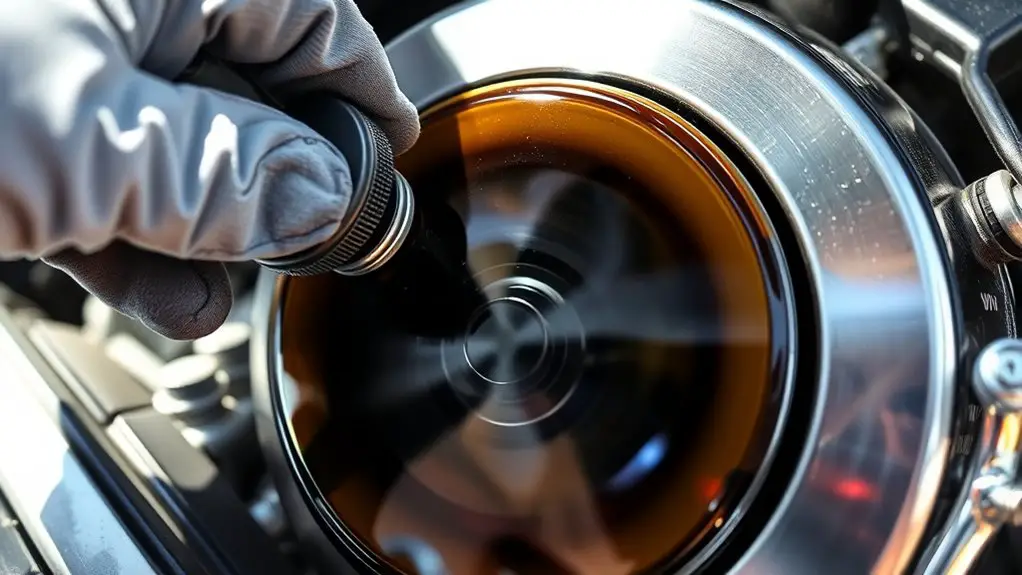
When replacing brake fluid, it’s essential to inspect the fluid condition to guarantee peak performance. Signs of contamination, such as discoloration or sediment, can indicate that the fluid is no longer effective. Neglecting this step could lead to brake system failure and compromise your safety on the road.
Importance of Fluid Inspection
Failing to check the condition of brake fluid can lead to costly and dangerous consequences. Regular fluid maintenance is essential for ensuring your braking system functions effectively. The inspection frequency should align with your vehicle manufacturer’s recommendations, as well as your driving conditions. Moisture and contaminants can degrade fluid performance, compromising braking efficiency. By neglecting inspections, you risk reduced braking power, increased wear on components, and even system failure. Make it a habit to assess fluid condition periodically, and don’t hesitate to consult a professional if you notice any irregularities. A proactive approach to fluid inspection not only enhances safety but also extends the lifespan of your brake system, allowing you the freedom to drive with confidence.
Signs of Contamination
Although brake fluid contamination may not be immediately visible, there are several signs indicating that your fluid needs attention. One clear indicator is brake fluid discoloration, which often manifests as a darker hue than the original amber color. This change suggests the fluid is degrading and absorbing moisture. Moisture absorption is a critical concern; even a small amount of water can greatly lower the fluid’s boiling point, increasing the risk of brake failure under heat. Additionally, check for any visible particles or debris in the fluid, which could signify further contamination. Regularly inspecting your brake fluid helps maintain peak performance and safety, allowing you to drive with confidence. Don’t overlook these signs; they can be pivotal for your vehicle’s braking system.
Not Cleaning the Brake Fluid Reservoir
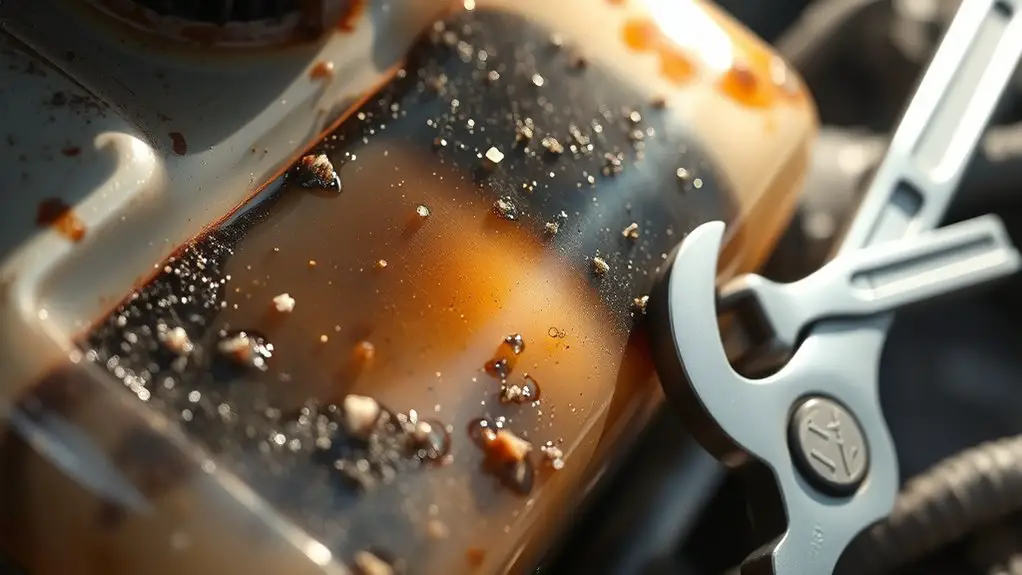
When you replace brake fluid, neglecting to clean the brake fluid reservoir can lead to serious contamination issues. Residue and debris can compromise the new fluid’s effectiveness and may cause damage to the braking system. Ensuring cleanliness is essential for maintaining ideal brake performance and longevity.
Importance of Cleanliness
How essential is it to keep the brake fluid reservoir clean during a fluid replacement? Maintaining brake fluid cleanliness is critical for your vehicle’s braking performance. A dirty reservoir can introduce contaminants into the new fluid, compromising its effectiveness and leading to potential system failure. When you neglect to clean the reservoir, you’re increasing the risk of moisture and debris mixing with the fresh fluid. This not only hampers braking efficiency but can also cause damage to components like seals and calipers over time. To guarantee peak performance and longevity of your braking system, prioritize cleanliness during the fluid replacement process. Remember, effective contamination prevention begins with a spotless reservoir, safeguarding your vehicle’s safety and performance.
Preventing Contamination Issues
Maintaining a clean brake fluid reservoir is just the first step in preventing contamination issues during a fluid replacement. You’ll want to verify that the area around the reservoir is free from debris and contaminants. When you open the reservoir, avoid introducing dirt or moisture from the environment, as these are common contamination sources. Use a clean funnel for fluid storage to minimize exposure. Always inspect your brake fluid for discoloration or particulates before adding new fluid; if you notice any, it’s best to flush the entire system. Finally, make sure the cap is securely fastened after the process, as this helps keep contaminants out. Prioritizing cleanliness guarantees peak brake performance and longevity.
Overlooking Brake Bleeding
Although replacing brake fluid is essential for maintaining ideal braking performance, many car owners overlook the necessary step of brake bleeding. Proper brake bleeding techniques guarantee that air bubbles are removed from the system, which can compromise brake efficiency and safety.
Here’s a quick overview of common bleeding errors:
| Common Bleeding Errors | Consequences |
|---|---|
| Not following the correct order | Air pockets remain |
| Inadequate fluid replacement | Contaminated fluid persists |
| Failing to check for leaks | Reduced braking power |
| Using incorrect tools | Damaged components |
| Neglecting to monitor pedal feel | Unreliable brake response |
Neglecting to Check for Leaks
When you replace brake fluid, it’s essential not to overlook the importance of checking for leaks. Effective leak detection is vital for maintaining your vehicle’s braking system. After replacing the fluid, perform a thorough fluid inspection on all brake lines and connections. Look for any signs of fluid seepage or wetness around the master cylinder, calipers, and wheel cylinders. Even small leaks can lead to significant brake performance issues, risking your safety.
If you notice any leaks, address them immediately before driving. Use appropriate tools to tighten connections or replace faulty components. Remember, brake fluid is hygroscopic, meaning it absorbs moisture, which can compromise your braking system.
Using Contaminated Tools
After verifying there are no leaks, it’s important to contemplate the tools you’ll use for replacing brake fluid. Using contaminated tools can compromise the integrity of your brake system, leading to potential failures. Proper cleaning of all tools beforehand is vital to avoid introducing dirt or residual fluids into the brake lines.
Here are some key considerations:
- Inspect Tools: Check for any signs of corrosion or residue.
- Clean Thoroughly: Use appropriate solvents to confirm all tools are free of contaminants.
- Use Dedicated Tools: Whenever possible, use tools specifically designated for brake fluid replacement.
- Store Properly: Keep tools in a clean, dry environment to prevent future contamination.
Skipping Safety Precautions
Neglecting safety precautions during brake fluid replacement can lead to serious accidents and injuries. You should always wear protective gloves and goggles to safeguard against brake fluid’s corrosive nature. This fluid can damage your skin and eyes, making it important to prioritize your personal safety. Make sure you’re working in a well-ventilated area to avoid inhaling harmful fumes, which can compromise your health.
Additionally, keeping your workspace organized is essential for brake safety. Remove any flammable materials nearby, as brake fluid can be ignitable. Using jack stands instead of just a jack is another important maintenance practice; this provides stability while you work under the vehicle.
Replacing Fluid Without a Plan
When replacing brake fluid, having a clear plan is essential for success. You need to gather the recommended tools and follow a scheduled maintenance checklist to guarantee everything goes smoothly. Without proper preparation, you risk making errors that could compromise your vehicle’s braking system.
Importance of Preparation
Although it might seem straightforward, replacing brake fluid without a detailed plan can lead to significant issues down the line. A well-prepared approach guarantees your brake system functions at its best and remains safe. Here are key considerations to keep in mind:
- Check the vehicle’s manual for specific brake fluid types.
- Make sure you have the correct tools and materials before starting.
- Understand the brake system’s layout to avoid unnecessary complications.
- Schedule this task during your regular maintenance routine for better results.
Recommended Tools Required
To successfully replace brake fluid, having the right tools on hand is vital for avoiding complications. Start with a reliable brake fluid reservoir filler or syringe, which allows for precise fluid transfer without spills. A brake bleeder kit is also important; it helps remove air from the system effectively. You’ll need a wrench to loosen and tighten bleed screws, ensuring a secure fit. Don’t forget a clean container for draining old brake fluid—this prevents contamination. Safety goggles and gloves protect your eyes and skin from corrosive brake fluid. Finally, having a funnel can make pouring new fluid straightforward. With these essential replacement tools, you’re well-equipped to tackle your brake fluid replacement confidently and efficiently.
Scheduled Maintenance Checklist
Having the right tools is just the first step in replacing brake fluid; creating a scheduled maintenance checklist is equally important. Without a plan, you might overlook essential steps, leading to poor performance or safety risks.
Consider including these items in your checklist:
- Fluid Type: Verify you’re using the correct brake fluid recommended for your vehicle.
- Inspection Schedule: Set specific intervals for checking and replacing brake fluid.
- System Bleeding: Plan for proper bleeding techniques to remove air bubbles after fluid replacement.
- Record Keeping: Document each fluid replacement to track maintenance history.
A well-structured scheduled maintenance checklist will help you avoid common mistakes, guaranteeing your fluid replacement process is efficient and effective. Embrace the freedom of informed maintenance!
Not Pumping the Brake Pedal
When replacing brake fluid, one common oversight is failing to pump the brake pedal after the fluid has been replaced. This critical step guarantees the hydraulic system is properly pressurized and eliminates air bubbles that may have entered during the fluid change. By pumping the brake pedal several times, you allow the new fluid to circulate throughout the system, which is essential for restoring peak braking performance.
Neglecting to pump the pedal can lead to a spongy feeling when you press down, indicating that the hydraulic system isn’t functioning correctly. This isn’t just a minor inconvenience; it can compromise your vehicle’s safety. After replacing the brake fluid, take the time to pump the brake pedal and check for a firm response. This simple action can save you from potential brake failure and guarantee your driving experience remains smooth and secure.
Overfilling the Reservoir
While it may seem harmless to fill the brake fluid reservoir to the brim, overfilling can lead to significant issues in your vehicle’s braking system. A reservoir overflow can occur, causing brake fluid to leak, which compromises brake performance. This not only creates a mess but can also lead to dangerous situations on the road.
Here are some potential consequences of overfilling the reservoir:
- Fluid Leakage: Excess fluid can escape from the reservoir, creating a hazard.
- Brake System Damage: Overpressure from excess fluid can damage seals and components.
- Reduced Brake Efficiency: Fluid may aerate, leading to a spongy brake pedal feel.
- Increased Maintenance Costs: Damage from overfilling can lead to costly repairs.
To guarantee ideal brake performance, always fill the reservoir to the manufacturer’s recommended level. Your safety and freedom depend on it.
Forgetting to Test the Brakes
Many DIY mechanics overlook the essential step of testing the brakes after replacing brake fluid. This vital oversight can compromise brake performance and safety. Once you’ve completed the fluid replacement, it’s imperative to employ effective testing methods to guarantee everything is functioning correctly.
Start by gently pressing the brake pedal to check for a firm response. If the pedal feels spongy or sinks to the floor, air may be trapped in the system, requiring further bleeding. Next, conduct a low-speed test drive in a safe area. Gradually apply the brakes to assess responsiveness and listen for any unusual sounds.
Delaying Maintenance
Delaying maintenance on your brake fluid can lead to significant safety issues and costly repairs down the line. Ignoring your maintenance schedule puts your brake performance at risk, potentially resulting in reduced stopping power or even brake failure. It’s essential to stay proactive and address brake fluid changes at the recommended intervals.
Delaying brake fluid maintenance jeopardizes safety and performance, leading to costly repairs and potential brake failure. Stay proactive for reliable braking.
Consider the following consequences of delaying brake fluid maintenance:
- Decreased Brake Performance: Old fluid can absorb moisture, lowering boiling points and effectiveness.
- Corrosion: Contaminants can lead to rust and damage within the brake system.
- Costly Repairs: Neglecting fluid changes may result in expensive component replacements.
- Safety Risks: Compromised brakes can lead to accidents, jeopardizing your safety and others on the road.
Stay ahead of the game by adhering to your maintenance schedule. Your freedom on the road hinges on reliable brake performance.
Ignoring Manufacturer Recommendations
Ignoring manufacturer recommendations when it comes to brake fluid replacement can lead to severe consequences for your vehicle’s braking system. Each vehicle is designed with specific brake fluid specifications that guarantee ideal performance and safety. By deviating from these manufacturer guidelines, you risk compromising the integrity of your braking system.
Using the wrong type of brake fluid can cause corrosion, decreased braking efficiency, or even total brake failure. For instance, mixing different DOT ratings can lead to fluid breakdown and vapor lock, which greatly affects responsiveness. It’s vital to adhere to the manufacturer’s recommendations, including the correct fluid type and replacement intervals.
Always consult your vehicle’s owner manual or a trusted mechanic to verify you’re using the right brake fluid. By respecting these specifications, you not only enhance your driving experience but also maintain your freedom on the road. Prioritize safety by following these essential guidelines for brake fluid maintenance.
Frequently Asked Questions
How Often Should I Replace My Brake Fluid?
You should replace your brake fluid every two years or as specified in your vehicle’s manual. This replacement schedule helps maintain peak brake performance and safety. Brake fluid absorbs moisture over time, which can lead to corrosion and reduced braking efficiency. Regularly checking the fluid’s condition and level can also help you catch any potential issues early. Staying on top of this maintenance guarantees your vehicle operates smoothly and safely.
Can I Mix Different Types of Brake Fluid?
You shouldn’t mix different types of brake fluid. Each brake fluid type, like DOT 3, DOT 4, or DOT 5, has unique properties that affect performance and safety. Mixing fluids can lead to reduced boiling points, increased moisture absorption, and potential system corrosion. Always stick with the same type specified for your vehicle. If you’re unsure, it’s best to completely flush the system and refill with the appropriate brake fluid type for peak performance.
What Symptoms Indicate Low Brake Fluid?
When your brake fluid levels are low, you’ll notice several warning signs. You might experience a spongy or soft brake pedal, which indicates insufficient hydraulic pressure. Additionally, your dashboard may display a brake warning light, signaling a fluid issue. If you hear unusual noises when braking or if your vehicle takes longer to stop, it’s crucial to check the brake fluid levels immediately to guarantee your safety and maintain peak braking performance.
Is It Safe to Drive With Old Brake Fluid?
No, it’s not safe to drive with old brake fluid. Brake fluid degradation can greatly impact your braking system’s performance, leading to reduced responsiveness and potential brake failure. Old fluid absorbs moisture, which lowers the boiling point and compromises driving safety. If you notice a spongy brake pedal or diminished braking power, it’s essential to replace the fluid. Prioritizing your vehicle’s maintenance guarantees you enjoy the freedom of safe, reliable driving.
How Can I Tell if My Brakes Need Bleeding?
You can tell your brakes need bleeding if you notice a spongy or soft pedal, contrasting the firm feel of healthy brake performance. This often indicates fluid contamination or air trapped in the lines. Also, if your braking response feels sluggish or inconsistent, it’s a sign that the hydraulic system isn’t functioning properly. Regularly checking your brake fluid quality can help maintain safety and enhance your driving freedom.

